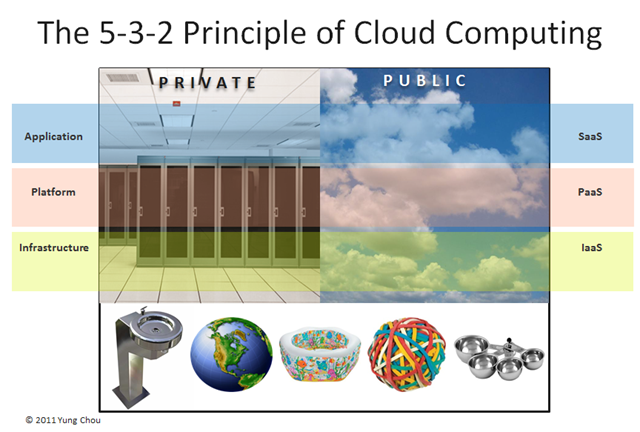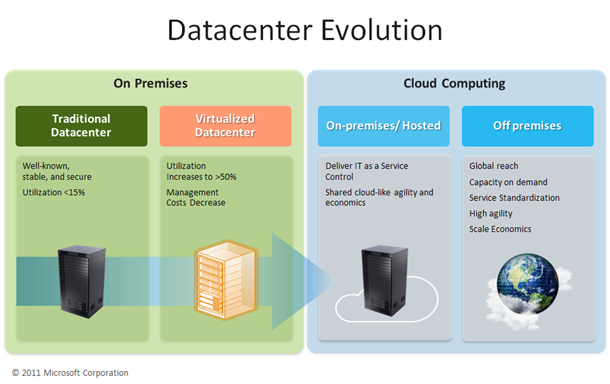Private Cloud, Public Cloud, and Hybrid Deployment
As of August, 2011, US NIST has published a draft document (SP 800-145) which defines cloud computing and outlines 4 deployment models: private, community, public, and hybrid clouds. At the same time, Chou has proposed a leaner version with private and public as the only two deployment models in his 5-3-2 Principle of Cloud Computing. The concept is illustrated below.
Regardless how it is viewed, cloud computing characterizes IT’s capabilities with which a set of authorized resources can be abstracted, managed, delivered, and consumed as a service, i.e. with capacity on demand, without the concerns of underlying infrastructure. Amid a rapid transformation from legacy infrastructure to a cloud computing environment, many IT professionals remain struggling in better understanding what is and how to approach cloud. IT decision makers need to be crisp on what are private cloud and public before developing a roadmap for transitioning into cloud computing.
Private Cloud and Public Cloud
Private cloud is a “cloud” which is dedicated, hence private. As defined in NIST SP 800-145, private cloud has its infrastructure operated solely for an organization, while the infrastructure may be managed by the organization or a third party and may exist on premise or off premise. By and large, private cloud is a pressing and important topic, since a natural progression in datacenter evolution for the post-virtualization-era enterprise IT is to convert/transform existing establishments, i.e. what have been already deployed, into a cloud-ready and cloud-enabled environment, as shown below.
NIST SP 800-145 points out that public cloud is a cloud infrastructure available for consumers/subscribers and owned by an organization selling cloud services to the public or targeted audiences. Free public cloud services like Hotmail, Windows Live, SkyDrive, etc. and subscription-based offerings like Office 365, Microsoft Online Services, and Windows Azure Platform are available in Internet. And many simply refer Internet as the public cloud. This is however not entirely correct since Internet is in generally referenced as connectivity and not necessary a service with the 5 essential characteristics of cloud computing. In other words, just because it is 24x7 accessible through Internet does not make it a cloud application. In such case, cloud computing is nothing more than remote access.
Not Hybrid Cloud, But Hybrid Deployment
According to NIST SP 800-145, hybrid cloud is an infrastructure of a composition of two or more clouds. Here these two or more clouds are apparently related or have some integrated or common components to complete a service or form a collection of services to be presented to users as a whole. This definition is however vague. And the term, hybrid cloud, is extraneous and adds too few values. A hybrid cloud of a corporation including two private clouds from HR and IT, respectively, and both based on corporate AD for authentication is in essence a private cloud of the corporation, since the cloud as a whole is operated solely for the corporation. If a hybrid cloud consists two private clouds from different companies based on established trusts, this hybrid cloud will still be presented as a private cloud from either company due to the corporate boundaries. In other words, a hybrid cloud of multiple private clouds is in essence one logical private cloud. Similarly a hybrid cloud of multiple public clouds is in essence a logical public cloud. Further, a hybrid cloud of a public cloud and a private cloud is either a public cloud when accessing from the public cloud side or a private cloud from the private cloud side. It is either “private” or “public.” Adding “hybrid” only confuses people more.
Nevertheless, there are cases in which a cloud and its resources are with various deployment models. I call these hybrid deployment scenarios including:
- An on-premise private cloud integrated with resources deployed to public cloud
- A public cloud solution integrated with resources deployed on premises
I have previously briefly talked about some hybrid deployment scenarios. In upcoming blogs, I will walk through the architectural components and further discuss either scenarios.
Closing Thoughts
A few interesting observations I have when classifying cloud computing. First, current implementation of cloud computing relies on virtualization and a service is relevant only to those VM instances, i.e. virtual infrastructure, where the service is running. Notice that the classification of private cloud or public cloud is not based on where a service is run or who owns the employed hardware. Instead, the classification is based on whom, i.e. the users, that a cloud is operated/deployed for. In other words, deploying a cloud to a  company’s hardware does not automatically make it a private cloud of the company’s. Similarly a cloud hosted in hardware owned by a 3rd party does not make it a public cloud by default either.
company’s hardware does not automatically make it a private cloud of the company’s. Similarly a cloud hosted in hardware owned by a 3rd party does not make it a public cloud by default either.
Next, at various levels of private cloud IT is a service provider and a consumer at the same time. In an enterprise setting, a business unit IT may be a consumer of private cloud provided by corporate IT, while also a service provider to users served by the business unit. For example, the IT of an application development department consumes/subscribes a private cloud of IaaS from corporate IT based on a consumption-based charge-back model at a departmental level. This IT of an application development department can then act as a service provider to offer VMs dynamically deployed with lifecycle management to authorized developers within the department. therefore, when examining private cloud, we should first identify roles, followed by setting proper context based on the separation of responsibilities to clearly understand the objectives and scopes of a solution.
Finally, community cloud as defined in NIST SP 800-145 is really just a private cloud of a community since the cloud infrastructure is still operated for an organization which now consists a community. This classification in my view appears academic and extraneous.






